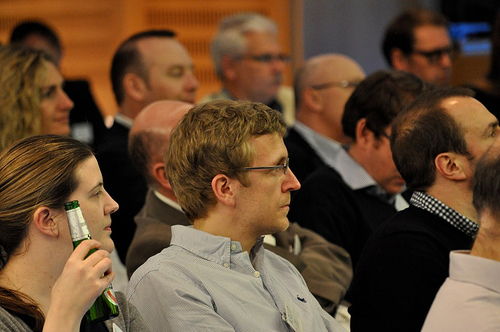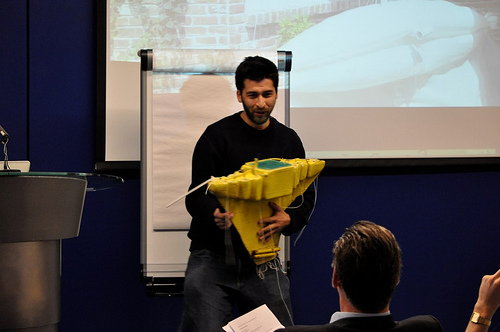Union event: User makers and distributed production
Over the past couple of months, I’ve been helping Duncan Wilson (Arup), and Roland Harwood (100%Open), put together an evening of pitches, inspiration and networking called Union.
The theme was “User makers and distributed production”. A subject that’s difficult to encapsulate neatly, but certainly covers areas like:
- Open source hardware (that can be hacked and customised after manufacture)
- Low-cost prototyping tools (e.g. microprocessors and fabrication technology)
- Small-scale personalised production (e.g. digitally produced gifts)
- Remote, on-demand fabrication services (e.g. Shapeways, Ponoko, et al)
- Emerging domestic fabrication technology (3D printers for the home)
- Increased access to hi-tech manufacturing (e.g. for printed circuit boards) in China for user-makers wanting to move beyond prototypes
On Thursday night, we gathered at Arup’s offices in London to hear 18 lightning pitches from grassroots groups, startups, designers and technologists, SMEs and corporates. If you can imagine Ignite, Maker Faire and TED all rolled into one, you’d have a pretty good impression of the evening.
I can’t cover everything that was shared, but a number of themes emerged which I found interesting.
Shared workspaces drive innovation
While the new fabrication technologies (laser cutters, CNC machines, fabric and vinyl cutters, 3D printers, etc.) are low-cost, they’re still beyond the means of most individuals. So, for hardcore makers, community workshops have become established as key hubs within the maker network.
Mark Hatch, CEO of TechShop, told us of their remarkable success in enabling innovation and enterprise in the US, by providing access to tools and a community of fellow makers. Everything from the world’s first self-balancing bar stool, to the DODOcase (Obama’s favoured iPad case, it seems). The sheer volume of startups that had emerged from TechShop’s workshops was astounding.
We don’t have any TechShops (yet) in the UK, but we do have a wealth of hackspaces. One of the most pioneering is the London Hackspace. Andy ‘Bob’ Brockhurst came along to talk about some of the projects that have found a home there. Spend an evening at LHS and you can have a DNA-sequenced curry from Brick Lane, and then try and sneak your washing up past the Kinect-controlled kitchen-sink plate-pile detector.
Every town should have a hackspace, fablab or TechShop – and they are springing up everywhere – but in some ways I’m more interested in how other work or play spaces might take on some of the functions and capabilities of a workshop. For example, schools are increasingly equipped with such machines, how about opening them up for experimentation beyond the confines of the school day and the school curriculum? I’m also reminded of Phillip Torrone’s proposal to turn public libraries into hackspaces.
Xavier De Kestelier of Foster + Partners, shared his side-project, Smartgeometry, an online community of architects and designers, from practice, research and academia, that meets up once a year for a creative hothouse that pushes disciplines together for 5 days of intensive hacking and learning. I was particularly struck by the photos he showed of the workshop, where people were using computers and fabrication machinery in the same space.
I for one, would love to work in a space like this.
Designers are playing beyond the screen
Low cost micro-controllers like Arduino, wireless networking communication like RFID, and ‘well-hooked’ web services like Pachube or even Twitter are spurring a revolution in the design of physical objects and digital services. The two worlds are being brought together into an “internet of things”. Whilst that term can have many meanings, one facet is that of physical objects that are networked, and can share information about their status, sensors, and so on.
For designers used to working with dumb lumps of matter, networked objects give them the opportunity to introduce intelligence (of a sort) and interactivity. For screen-based developers, the lure of tangibility is hard to resist.
Gonzalo Garcia-Perate, a PhD researcher at Arup Foresight, talked about Hintsights, a cloud service and table-top device that lets users access data streams in a domestic setting away from the computer screen.
Projects like this are endlessly fascinating to geeks (including me) who can see their potential for creative re-use/abuse. But in a way I’m more excited by their domesticity than their hackability. Berg’s Little Printer hooks into a similar insight – the appetite for a friendly, physical, off-screen interface to networked data.
Greg Saul, from Diatom, showed off their Sketchchair project, which also has a digital and a physical component. Simple human-centred software for designing and manufacturing chairs, and remote, personalised fabrication; clever in how it uses constraints to enable simplicity. The software is specialised to the task of designing a chair, complete with physics models and pose-able sitters. It doesn’t come laden with unnecessary features of a generalised 3D program. And the output is specific to the physical fabrication process, which uses a CNC machine to cut out planes of the chair, which can be shipped back to you and assembled into a finished product.
Foundations of hardware innovation
Sketchchair was one of several projects that had received a kick start from Kickstarter, the crowd-funding platform. One of the others was Cesar Harada’s Protei project, an open source sailing drone that makes use of a flexible hull design to enable the vessel to carry heavy loads through the water, powered by wind. They hope this technology could change the way oil spills and other ocean waste is cleaned up.
Protei is built on open-hardware principles, and Cesar was quick to show how the network of interested hackers had improved their design and provided a community of support to help them gain backing and sustain the project.
One of the projects Bob Brockhurst talked about was Nanode, an open source derivation of the Arduino prototyping platform with built-in network connectivity. Started at LHS, they’ve now spun it out into a separate company. Again, an enterprise enabled by both open-source hardware and a community hackspace.
There is much more to be said on the subject, but these factors: crowd-funding, open source hardware, communities of hackers are, it seems, key of the foundations for innovation in hardware, particularly for hackers wanting to move into business.
Puzzles: Working at scale
These are all exciting, inspiring, optimistic themes, but I think it’s most interesting to look for the puzzles. I’m personally very interested in how we can bring hackers into the corporate innovation world. It’s one of the I want to explore in this year’s Brighton Mini Maker Faire. How can we give amateur (and I mean that word in its literal sense) makers access to the resources of corporate enterprise? And how can we open up corporate innovation to embrace small-scale (but high-impact) disruption from the grassroots maker/hacker communities?
But if I could draw the threads of the evening together into one puzzle, it would be:
How do you apply the creative forces behind the maker movement at scale?
Leo Poll, of Philips, saw the potential of hacking for innovation when he came to the UK from the Netherlands (a country apparently constrained by regulations that hinder user-makers, and their ability to innovate, post-design). He made a call out for collaboration with grassroots makers within the enterprise.
Jane ni Dhulchaointigh shared with us the story of Sugru, the mouldable silicon putty for fixing and modifying things. Like many of the other projects we heard about, Sugru has grown organically, supported by the community, who love to share their experiences of the product. Sugru have a foothold in many diverse communities: engineers, photographers, gadget enthusiasts, etc. She wanted to know how she could raise her business to the next level, building support in much larger communities
And talking to some of the corporates there, like Fujitsu and Arup, it was clear that many larger enterprises are still working out how to incorporate hacking into their practice; how to bring back physical craft into design processes dominated by digital tools, how to hook up communities of external, non-corporate problem solvers with internal business units unused to looking outwards for help.
Many thanks to Duncan and Arup Foresight for hosting us. And most of the photos in this post are from their Flickr stream. I hope we have the opportunity to do it again soon.
And if you have questions or insights to share on how to bring enterprise and makers together, or how we can play by the maker rulebook at scale, I’d love to hear them.
-
- *Update, 15 March:
A version of this piece has also been posted over on the 100%Open blog, and you can also read Duncan’s take on the event on the Arup Foresight blog.</p>




